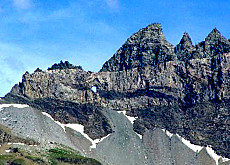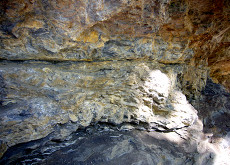
The Glarus Overthrust, a rock formation that provides unique insights into the formation of the Alps, is bidding to become Switzerland's eighth world heritage site.
swissinfo visited the overthrust, which stretches for 40km across eastern Switzerland, to find out what makes it different from all the other rock shelves thrusting around the world.
"Overthrusts are found everywhere - they occur in every mountain-building process - but not as visibly and on the scale as that at Glarus," Mark Feldmann from Geo-Life, a Glarus-based geology company, told swissinfo.

The Glarus Overthrust is certainly impressive - a massive sheet of rock rising out of the ground and undulating across Glarus, St Gallen and Graubünden - but this is not enough for Unesco world heritage site status.
"The critical factor is what's called 'outstanding universal value'," James Powell, a geologist, told swissinfo. "It's all about being unique."
Powell is one of two experts from the World Conservation Union (IUCN), which on behalf of Unesco, the United Nations cultural agency, evaluates candidates' claims to uniqueness and other criteria such as management plans and public education.
"As a natural site - as in all parts of the Alps - it is very attractive, but we're not talking about the landscape as such but rather the importance of the thrust," Powell said.
Swiss geologists are in no doubt that the Glarus Overthrust deserves to be a world heritage site, but ongoing assessment of its uniqueness and scientific significance means they will have to wait until Unesco's general assembly in Quebec in July 2008 for the verdict.
Few disciplines have seen - and continue to see - as many conflicting theories as geology, the science and study of the solid matter that constitutes the earth. Indeed recent Gallup polls estimate that around half of Americans believe the earth was created within the past 10,000 years.
The earth is in fact around 4.5 billion years old, but the oldest parts of the Glarus Overthrust are a fresh 260 million years old.
The Alps - like the Himalayas and the Andes - are fold mountains: tectonic plates collide and the earth's crust buckles.
Normally younger rock layers are found on top of older rock layers - rather like tree rings - but what caused countless geological headaches was the discovery at the beginning of the 19th century that the top layer in the Glarus Overthrust was older than the bottom layer (260 million years old versus 35 million years old).
This was the first time this geological oddity had ever been observed, and cracking it went a long to way to explaining the formation of the Alps.
Various theories were proposed and pooh-poohed, but the accepted theory now is that complete plates were forced up and over shallower ones, using a layer of fine-grained mylonite limestone as a lubricant.
Adrian Pfiffner, professor of geology at Bern University, said the overthrust's "striking visibility" was one reason why it should be awarded heritage site status.
"Also, geologists can study parts of the thrust that were once at least 15km beneath the earth's crust... whereas in other thrust folds you only see one segment which is usually closer to the earth's surface," Pfiffner told swissinfo.
"Another point is the lubricant - a layer along the thrust fold which enabled gliding. It is unique to see such a mylonite which has been dragged out along such a distance."
So is the Glarus Overthrust a holy place for geologists? "I think all scientists who work in tectonics or structural geology visit the Glarus Overthrust at least once in their lives," said Feldmann.
As for the overthrust's chances, Pedro Rosabal, the second IUCN assessor, ominously compared it to an Oscar: "Being nominated is already a success."